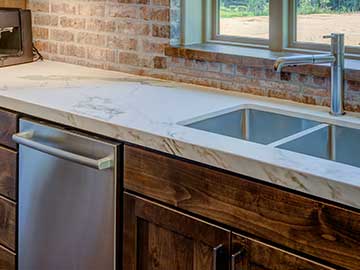
Plumbing problems come in all shapes and sizes. Having your kitchen sink fill up with water whenever you run the dishwasher is not a major disaster nor is it an emergency but it still is a sign of a problem. And one thing you want to avoid is for plumbing problems to go from small to big!
The question then is “Why is my kitchen sink filling up with water when I run the dishwasher?” – the answer could be anyone of four issues:
- There’s a clog in your sink’s air gap.
- There’s a clog in your sink’s drain pipe.
- There’s a clog or obstruction in your dishwasher.
- There’s a clog in your garbage disposal.
Let’s go through each one of these issues individually.
A Clog In Your Sink’s Air Gap
According to Wikipedia “A common use of the term “air gap” in home plumbing refers to a fixture that provides back-flow prevention for an installed dishwasher. This “air gap” is seen above the sink as a small cylindrical fixture mounted parallel with the faucet. In the base cabinet under the sink, the drain hose from the dishwasher feeds the “top” of the air gap, and the “bottom” of the air gap is plumbed into the sink drain below the basket, or into a garbage disposal unit.”
If you notice that yes, you do have an air gap installed – it could be that water is backing up into the sink because of a clog in that air gap.
How To Clean and Maintain Your Air Gap
Here are some simple steps on how you can clean out your air gap and keep it from clogging up again.
- Remove the top cover
- Unscrew (or unsnap) the inner cap
- If you can see a clog, work on removing it
- A useful tool for this process is a 12 inch bottle brush
Note: You may not always see the clog so don’t assume that there isn’t one. Use the bottle brush to clean out the air gap and it may reveal a clog further down.
A Clog In Your Sink’s Drain Pipe
If you have a clog in your sink it may be that your dishwasher isn’t able to drain properly and ends up backing up, into your sink.
Here are 3 quick and easy things you can do to try and unclog your sink.
- Run your garbage disposal – A good rule of thumb to remember is to run your garbage disposal for a just few seconds before you turn on your dishwasher. The reason is that this helps to dislodge any debris that may keep your dishwasher from draining properly.
- Try any of the over the counter products that you can try to unclog your sink drain.
- Use a snake drain (i.e. auger) to dislodge that clog in your sink.
A Clog In Your Dishwasher
Open your dishwasher and take a look at the bottom. Do you see a little bit of water or do you see standing water covering the entire bottom of your dishwasher?
It’s normal to have some water but if you see more than that – then there’s likely a clog somewhere in your dishwasher.
Here are some simple things you can do.
- Check to see if anything is in the way of the drain in your dishwasher. Of course if you see something, then remove it.
- Pull out the dishwasher and check the drain hose – there may be a clog in there.
A maintenance note to mention here is to make sure that you are not using the wrong kind of detergent for your dishwasher and also that you’re not using too much detergent. Both of these issues can cause some buildup which can then lead to a clog.
If you’re not sure about the kind of detergent to use – check the paperwork that came with your dishwasher or check online. Almost all major brands have their appliance maintenance information on their websites.
Clog In The Garbage Disposal
The last issue we’re going to discuss here is a clog in your garbage disposal which could then lead to water backing up into your sink.
The mistake many homeowners make is to think that their garbage disposal can act as a “food processor” of sorts for leftovers. In actuality – it’s really meant to be used for very small amounts of food.
Check out our list of what NOT to put in your garbage disposal.
We recommend that you call in a professional plumber to clear out a clogged garbage disposal – mainly because you could end up causing more damage which may result in having to get a new disposal unit. But, with that being said, if you wish to try it yourself, here are some things that you can do to try and unclog your garbage disposal.
- Turn off your garbage disposal first. In fact, you may want to turn off the power to the unit just in case
- Manually turn the blades of the disposal (with a screwdriver) and see if you can unlodge whatever may be clogging it
- You may need a pair of pliers or long tongs to remove any debris in the disposal
- You can also use a plunger to loosen up anything that may be causing the clog
- Clean out the P-trap underneath the garbage disposal and clean that out (if needed)
- A pictoral “how to” can be found on WikiHow
If you are having problems with water backing up in your kitchen sink or clogs that you can’t seem to get rid of, call the Atlanta plumbing experts – Atlantis Plumbing today at 770-505-8570. We are available 24 hours a day, 7 days a week.